西安电子科技大学:《无线通信理论》课程教学资源(PPT课件)Fundamentals of Wireless Communication Chapter6 Opportunistic Communication and Multiuser Diversity
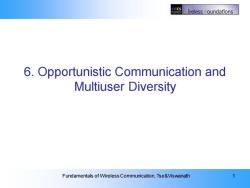
ECS Wireless F oundations 6.Opportunistic Communication and Multiuser Diversity Fundamentals of Wireless Communication,Tse&Viswanath
6: Opportunistic Communication and Multiuser Diversity Fundamentals of Wireless Communication, Tse&Viswanath 1 6. Opportunistic Communication and Multiuser Diversity
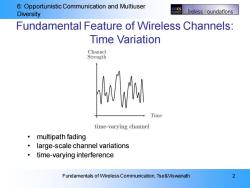
6:Opportunistic Communication and Multiuser EECS Diversity Wireless oundations Fundamental Feature of Wireless Channels: Time Variation Channel Strength Time time-varying channel ·multipath fading large-scale channel variations time-varying interference Fundamentals of Wireless Communication,Tse&Viswanath 2
6: Opportunistic Communication and Multiuser Diversity Fundamentals of Wireless Communication, Tse&Viswanath 2 Fundamental Feature of Wireless Channels: Time Variation • multipath fading • large-scale channel variations • time-varying interference
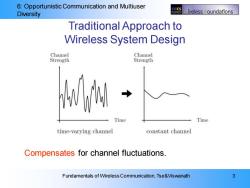
6:Opportunistic Communication and Multiuser ECS Diversity Wireless F oundations Traditional Approach to Wireless System Design Channel Channel Strength Strength Time Time time-varying channel constant channel Compensates for channel fluctuations. Fundamentals of Wireless Communication,Tse&Viswanath 3
6: Opportunistic Communication and Multiuser Diversity Fundamentals of Wireless Communication, Tse&Viswanath 3 Traditional Approach to Wireless System Design Compensates for channel fluctuations
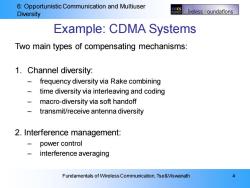
6:Opportunistic Communication and Multiuser ECS Diversity vireless oundations Example:CDMA Systems Two main types of compensating mechanisms: 1.Channel diversity: frequency diversity via Rake combining time diversity via interleaving and coding macro-diversity via soft handoff transmit/receive antenna diversity 2.Interference management: 一 power control interference averaging Fundamentals of Wireless Communication,Tse&Viswanath 4
6: Opportunistic Communication and Multiuser Diversity Fundamentals of Wireless Communication, Tse&Viswanath 4 Example: CDMA Systems Two main types of compensating mechanisms: 1. Channel diversity: – frequency diversity via Rake combining – time diversity via interleaving and coding – macro-diversity via soft handoff – transmit/receive antenna diversity 2. Interference management: – power control – interference averaging
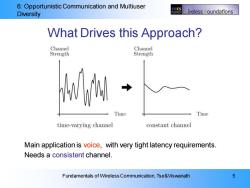
6:Opportunistic Communication and Multiuser EECS Diversity Wireless F oundations What Drives this Approach? Channel Channel Strength Strength Time Time time-varying channel constant channel Main application is voice,with very tight latency requirements. Needs a consistent channel. Fundamentals of Wireless Communication,Tse&Viswanath 5
6: Opportunistic Communication and Multiuser Diversity Fundamentals of Wireless Communication, Tse&Viswanath 5 What Drives this Approach? Main application is voice, with very tight latency requirements. Needs a consistent channel
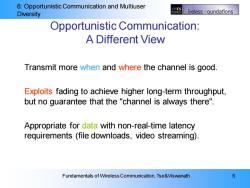
6:Opportunistic Communication and Multiuser EECS Diversity ireless oundations Opportunistic Communication: A Different View Transmit more when and where the channel is good. Exploits fading to achieve higher long-term throughput, but no guarantee that the "channel is always there". Appropriate for data with non-real-time latency requirements (file downloads,video streaming). Fundamentals of Wireless Communication,Tse&Viswanath 6
6: Opportunistic Communication and Multiuser Diversity Fundamentals of Wireless Communication, Tse&Viswanath 6 Opportunistic Communication: A Different View Transmit more when and where the channel is good. Exploits fading to achieve higher long-term throughput, but no guarantee that the "channel is always there". Appropriate for data with non-real-time latency requirements (file downloads, video streaming)
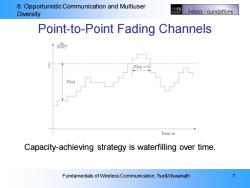
6:Opportunistic Communication and Multiuser EECS Diversity Wireless F oundations Point-to-Point Fading Channels P[m]=0 P(m Time m Capacity-achieving strategy is waterfilling over time. Fundamentals of Wireless Communication,Tse&Viswanath
6: Opportunistic Communication and Multiuser Diversity Fundamentals of Wireless Communication, Tse&Viswanath 7 Point-to-Point Fading Channels Capacity-achieving strategy is waterfilling over time
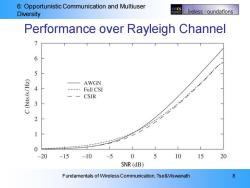
6:Opportunistic Communication and Multiuser ECS Diversity ireless oundations Performance over Rayleigh Channel 7 6 5 AWGN 4 Full CSI CSIR 3 2 1 0 -20 -15 -10 -5 0 10 15 20 SNR (dB) Fundamentals of Wireless Communication,Tse&Viswanath 8
6: Opportunistic Communication and Multiuser Diversity Fundamentals of Wireless Communication, Tse&Viswanath 8 Performance over Rayleigh Channel

6:Opportunistic Communication and Multiuser ECS Diversity Wireless F oundations Performance:Low SNR 3 2.5 2 CSIR Full CSI.. 1.5 1 050 -15 -10 -5 0 5 10 SNR [dB] At low SNR,capacity can be greater when there is fading. Fundamentals of Wireless Communication,Tse&Viswanath 9
6: Opportunistic Communication and Multiuser Diversity Fundamentals of Wireless Communication, Tse&Viswanath 9 Performance: Low SNR At low SNR, capacity can be greater when there is fading
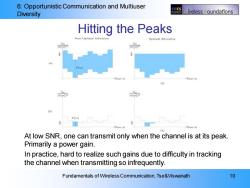
6:Opportunistic Communication and Multiuser EECS Diversity Nireless oundations Hitting the Peaks Near Optimal All Optimal Allocation Time (】 P(m] (b At low SNR,one can transmit only when the channel is at its peak. Primarily a power gain. In practice,hard to realize such gains due to difficulty in tracking the channel when transmitting so infrequently. Fundamentals of Wireless Communication,Tse&Viswanath 10
6: Opportunistic Communication and Multiuser Diversity Fundamentals of Wireless Communication, Tse&Viswanath 10 Hitting the Peaks At low SNR, one can transmit only when the channel is at its peak. Primarily a power gain. In practice, hard to realize such gains due to difficulty in tracking the channel when transmitting so infrequently
按次数下载不扣除下载券;
注册用户24小时内重复下载只扣除一次;
顺序:VIP每日次数-->可用次数-->下载券;
- 《无线通信理论》课程教学资源(PPT课件)Fundamentals of Wireless Communication Chapter5 Capacity of Wireless Channels.ppt
- 《无线通信理论》课程教学资源(PPT课件)Fundamentals of Wireless Communication Chapter4 Cellular Systems:Multiple Access and Interference Management.ppt
- 《无线通信理论》课程教学资源(PPT课件)Fundamentals of Wireless Communication Chapter3 Diversity.ppt
- 西安电子科技大学:《无线通信理论》课程教学资源(教案讲义)Lecture 9 多用户MIMO.pdf
- 西安电子科技大学:《无线通信理论》课程教学资源(教案讲义)Lecture 8 多天线分集复用折中.pdf
- 西安电子科技大学:《无线通信理论》课程教学资源(教案讲义)Lecture 7 MIMO容量与多天线复用技术.pdf
- 西安电子科技大学:《无线通信理论》课程教学资源(教案讲义)Lecture 6 MIMO信道模型.pdf
- 西安电子科技大学:《无线通信理论》课程教学资源(教案讲义)Lecture 5 多用户容量和机会通信.pdf
- 西安电子科技大学:《无线通信理论》课程教学资源(教案讲义)Lecture 4 衰落信道容量.pdf
- 西安电子科技大学:《无线通信理论》课程教学资源(教案讲义)Lecture 3 蜂窝系统与干扰分集.pdf
- 西安电子科技大学:《无线通信理论》课程教学资源(教案讲义)Lecture 2-3 频率分集技术.pdf
- 西安电子科技大学:《无线通信理论》课程教学资源(教案讲义)Lecture 2-2 空间分集技术.pdf
- 西安电子科技大学:《无线通信理论》课程教学资源(教案讲义)Lecture 2-1 时间分集技术.pdf
- 西安电子科技大学:《无线通信理论》课程教学资源(教案讲义)Lecture 1 信道模型(主讲:郑贱平).pdf
- 《无线通信理论》课程教学资源(参考教材)Fundamentals of Wireless Communication(英文版,共八部分).pdf
- 西安电子科技大学:《信号检测与估值》课程教学资源(课件讲稿,2019)第四章 波形信号检测.pdf
- 西安电子科技大学:《信号检测与估值》课程教学资源(课件讲稿,2019)第三章 统计信号估计(主讲:郑贱平).pdf
- 西安电子科技大学:《信号检测与估值》课程教学资源(课件讲稿,2019)第二章 衰落信道上的信号检测.pdf
- 西安电子科技大学:《信号检测与估值》课程教学资源(课件讲稿,2019)第一章 高斯信道上的信号检测.pdf
- 《通信原理》课程教学资源(辅导资料)Selected MIMO Techniques and their Performance.pdf
- 《无线通信理论》课程教学资源(PPT课件)Fundamentals of Wireless Communication Chapter8 MIMO II:Capacity and Multiplexing Architectures.ppt
- 安徽医科大学:《单片机原理与应用》课程教学大纲(生物医学工程专业)Application and principle of single chip microcomputer.pdf
- 西门子PLC培训教程(课件讲稿,共六章).pdf
- 电子电路分析制作与调试(PPT课件讲稿)直流可调稳压电源制作与调试.pdf
- 信阳师范大学(信阳师范学院):电子信息工程专业培养方案(2019版).pdf
- 信阳师范大学(信阳师范学院):电子科学与技术专业培养方案(2019版).pdf
- 信阳师范大学(信阳师范学院):电子信息工程专业课程教学大纲汇编(2015版).doc
- 信阳师范大学(信阳师范学院):电子科学与技术专业课程教学大纲汇编(2015版).doc
- 信阳师范大学:《电工电子》课程教学资源(实验讲义,打印版)《模拟电子线路》实验讲义(共十一个实验).pdf
- 信阳师范大学:《电工电子》课程教学资源(实验讲义,打印版)数字钟电路图.pdf
- 信阳师范大学:《电工电子》课程教学资源(实验讲义,打印版)多功能数字钟电路设计《数字电子技术》课程设计指导.pdf
- 信阳师范大学:《电工电子》课程教学资源(实验讲义,打印版)《电子技术基础实验》设计性实验报告范例.pdf
- 信阳师范大学:《电工电子》课程教学资源(实验讲义,打印版)《数字信号处理》实验指导书.pdf
- 信阳师范大学:《电工电子》课程教学资源(实验讲义,打印版)《PLC原理与应用》实验课程讲义(PLC实验指导讲义S7-200,共十一个实验).pdf
- 信阳师范大学:《电工电子》课程教学资源(实验讲义,打印版)三人表决电路.pdf
- 信阳师范大学:《电工电子》课程教学资源(实验讲义,打印版)《数字电子技术基础实验》讲义——集成单稳态触发的基本应用.pdf
- 信阳师范大学:《电工电子》课程教学资源(实验讲义,打印版)TFG1900A系列函数/任意波形发生器使用指南.pdf
- 信阳师范大学:《电工电子》课程教学资源(实验讲义,打印版)数字存储示波器GDS-1000A-U示波器使用手册.pdf
- 信阳师范大学:《电工电子》课程教学资源(实验讲义,打印版)《自动控制理论》实验指导书(共十一个实验).pdf
- 信阳师范大学:《电工电子》课程教学资源(实验讲义,打印版)《微型计算机原理及应用》实验讲义(共六个实验).pdf
